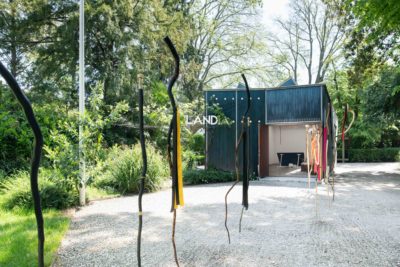
Wood, reindeer horn, metal, lace, reindeer moss, peat. Variable dimensions all photos Ugo Carmeni.
The Miracle Workers Collective (MWC) present their inaugural project, A Greater Miracle of Perception, for the Finnish Alvar Aalto Pavilion at the 58th International Art Exhibition – La Biennale di Venezia. Exploring the miracle as a poetic vehicle from which to expand perceptions and experiences, the exhibition presents MWC’s collective film work The Killing of Čáhcerávga (2019), which is in dialogue with the site-specific sculptural installation Ovdavázzit – Forewalkers (2019) by Outi Pieski.
Miracle Workers Collective manifests through an installation by Outi Pieski; a collective film by Maryan Abdulkarim, Khadar Ahmed, Hassan Blasim, Sonya Lindfors, Leena Pukki, Martta Tuomaala, Christopher L. Thomas, and Suvi West; and a modular set by Lorenzo Sandoval, with curators Giovanna Esposito Yussif, Christopher Wessels and Bonaventure Soh Bejeng Ndikung.
Expanding beyond the confines of the pavilion, Outi Pieski’s Ovdavázzit – Forewalkers similarly prompts questions around movement and borders. Paying homage to the artist’s Sámi ancestors, the installation brings into dialogue the Sámi tradi- tional handicraft, duodji, with contemporary art. Sharing both collective and personal histories and heritages, the installation gives voice to the complex internationalist discourse around the Sámi people’s collective struggle against colonial and nationalist enclosures.
Ovdavázzit – Forewalkers transports elements of the arctic tundra to the pavilion, through the series of “dancing” birch trees and reindeer lichen, a primary food source for reindeers. Arctic peoples have thrived in a harsh environment for millennia, thanks to their extensive knowledge of the land and waters. This ancestral, ecological knowledge is increasingly recognised as a crucial source for understanding Arctic biodiversity and to develop effective strategies for its conservation, learning from the Sámi philosophy of ‘agreeable life’, soabalaš eallin that points to a life in harmony and accordance with the earth.
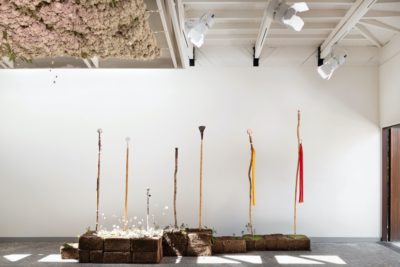
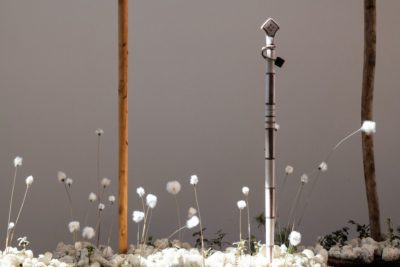
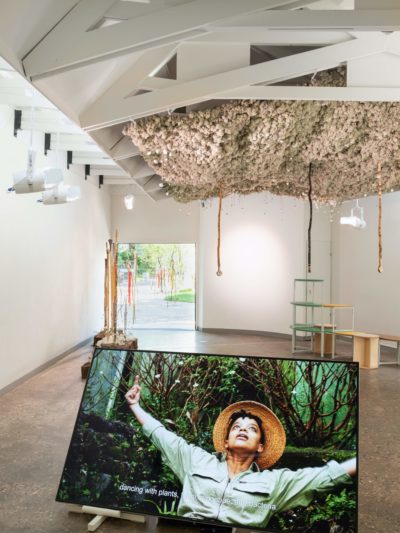
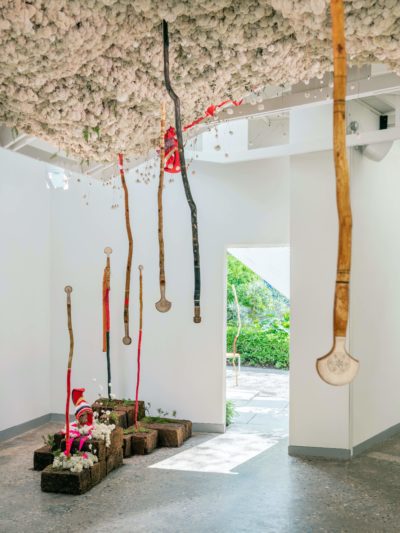
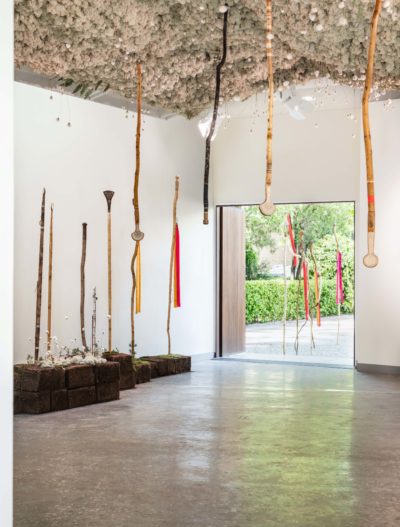
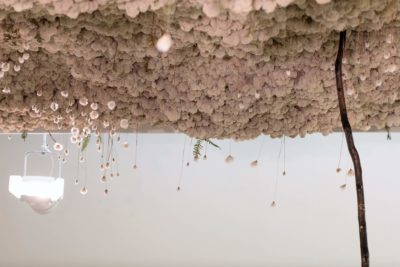
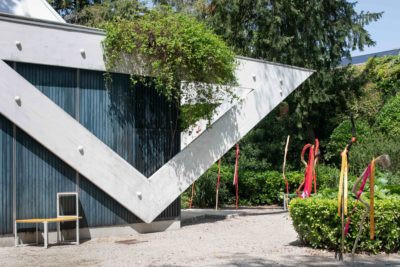
Outi Pieski installašuvdna Ovdavázzit – Forewalkers (2019) muitala sápmelaččaid máŋggaid buolvvaid bistán ja rájáid rastá dáhpáhuvvan oktasaš dáistaleames ássanguovlluideaset ja čázádagaideaset iešmearridanvuoigatvuođaid ovdii nationálastáhtaid ja priváhta fitnodatdoaimmaid vuostá. Dáidagis vuhtto mo eallima ja johtima vuođđun lea dat ahte eallit ceavzilis vugiin buohtalagaid duovdagiiguin ja daid dárbbuiguin. Sápmelaččaid orrunguovllu njealji riikka – Suoma, Ruoŧa, Norgga ja Ruošša – oinnolaš ja oaidnemeahttun rájit bajidit dáidagis gažaldagaid rájáid ja hálddašeami vuoigadahttimis ja rájáid rasttildeami privilegiijain (ovdavuoigatvuođain).
Dáidaga vázzinsoppiid ráidu rasttilda paviljoŋŋa rájáid ja doaibmá kompássan dahje vejolašvuohtan mearkut luottaid, mat ofelastet sápmelaččaid ja buohkaid geat leat massán eatnamiiddiset, geat leat áidojuvvon ja gillán politihka geažil. Sápmelaččaid kollektiiva ja persovnnalaš muitalusat ja árbevierut leat sárgojuvvon mearkan, hábmejuvvon geavjan ja čoarvečikŋan.
—-
Ovdavázzit – Forewalkers is Outi Pieski’s response for the Pavilion of Finland. This site-specific installation draws from Pieski’s collective praxis and recent collaborations, including the projects Rájácummá – Kiss from the Border (2017–2018) and The Moratorium Office (2018) developed with Sámi art- ists and activists Jenni Laiti and Niillas Holmberg. Through these works, they address forms of self-governance that abide to the Sámi philosophy of ‘agreeable life’, soabalaš eallin, that points to a life in harmony and accordance with the earth. Pieski’s long term research project Máttaráhku ládjogahpir – Foremother’s Horn Hat (2018– ongoing), de- veloped in collaboration with archeologist Eeva-Kristiina Harlin, also informs this installation. Pieski and Harlin inquire into the knowledges of the foremothers by investigating the ládjogahpir, a horn hat worn by Sámi women until the end of 19th century, through practices of revitalisation, rematriation and actualisation of the larger biocultural reality of the Sámi.
Through Ovdavázzit – Forewalkers, the artist ad- dresses the public dimension of walking as a de- mythologization of borders. It enunciates the complex transnationalist dimension concerning the Sámi’s collective struggle for self-determining the use and care of lands and waterways in which they dwell, against the contentions and exclusions operated through nationalist and exploitative corporativist dynamics. It signals how life and mobility are based in a sustainable co-existence with the needs of the region. Alluding to the visible and invisible borders that affect Sápmi, a culturalregion divided by four countries – Finland, Sweden, Norway, and Russia, the work brings to the fore questions such as, who has taken the rights to inflict borders and govern inside them?, and, in a time of global mobility crisis, who can walk through?
Following the holistic understanding of duodji, which is not merely a handicraft tradition but a technology of community belonging that encodes knowl- edges of nature and culture, the walking sticks that compose Ovdavázzit – Forewalkers inscribe collective and personal narratives and heritages through carved marks, forms of the handles, and reindeer horn incrustations. Five walking sticks have been commissioned by Pieski from the Sámi duojárs (artisans) Denis Barudkin, Per-Stefan Idivuoma, Nils-Johan Labba and Olavi Sakari Saijets, who live across the Sápmi region (Russia, Sweden and Norway respectively). As well, the installation brings different traces of the arctic tundra through the series of “dancing” birch trees and reindeer lichen – one of the main food sources for reindeers. The blocks of peat hint towards the peatland ecosystems as biodiversity archives, which are drained through heavy ex- traction as energetic sources, or as the lichens put in peril by intensive forestry, mining and agriculture.
Along this constellation, the flow of walking sticks traverse the boundaries of the pavilion serving as a compass or possibility for marking trajectories to guide the Sámi and all those whose territories have been intercepted, contained, and handicapped by the geography and politics of nation-states. Addressing wider, transnational collective struggles for self-de- termination that seek equal status for nature and people based on reciprocity, respect and dignity.
In Ovdavázzit – Forewalkers, Pieski also pays homage to the Sámi ancestors, those who wandered before her and are thus her forewalkers, and whose legacy is alive in Sámi culture today. Arctic peoples have thrived in a harsh environment for millennia, in no small part because they have acquired in-depth knowledges concerning the land and waters of their homelands and the species that live there, which provide food, clothing and meaning to Arctic cultures. These tradi- tional ecological knowledges are increasingly recognized as important epistemological sources for, among other things, understanding Arctic biodiversity and developing effective strategies to conserve that biodiversity, including indigenous ways of life.